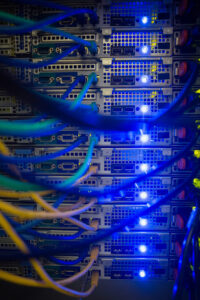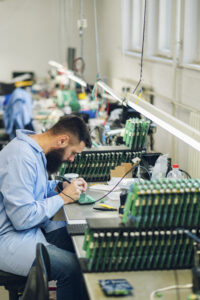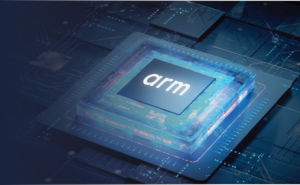In a data center, uptime is key. Nothing kills uptime like a good power outage. Because of this, most data centers use diesel powered generators for backup power. Many data centers will have at least 12 hours of fuel onsite and dedicated fuel management software… The thing about backup generators is that the generator needs to start up before it can begin to supply power. Typically, some sort of backup power is used to supply consistent and clean power to the data center between the time the main power cuts off and until the backup generator can begin supplying power.
A short history
Prior to 2000, most data centers used UPS (uninterruptible power supply). Basically, deep cycle batteries attached to an inverter. These would power the servers in the data center for a few minutes (but not the AC units, which is another story). Typically, the servers where attached directly to the UPS. The UPS had a management board in it that would signal the servers to gracefully power down. Uptime back then was not so good.
Then in the early 2000s, flywheels were introduced into data centers to provide clean and temporary power during a power outage. Basically, a flywheel is attached to a motor to generate clean power. Clean power meaning, no power fluctuations opposed to no carbon emissions. If the power goes out, the kinetic energy stored in the flywheel would keep spinning the motor. When the diesel generator starts up, it could begin generating power. The flywheel never stops.
A few years later, there were stories about how capacitors could replace batteries in future hybrid cars. However, these capacitors would be called supercapacitors or ultracapacitors. By the 2010s, ultracapacitors were a commercially available part.
Different technologies
A quick background on the three energy storing capabilities and characteristics of each.
Batteries, flywheels and ultracapacitors store energy. They do it in different ways.
- Batteries store energy chemically
- Flywheels store energy kinetically
- Ultracapacitors store energy statically (like clouds in a thunderstorm)
Characteristics of each:
- Batteries, as most know, can discharge stored energy slowly, making them great for cellular phones, flashlights and all sort of devices that you’d typically want to use over a length of time. In data centers, batteries can take up a huge amount of space, require replacing and have EPA regulations for ventilation.
- Flywheels rely on a spinning mass. Unlike batteries, which power is rated in the minutes, in flywheel systems are rated in the seconds. Per kW, flywheel systems are known to take up less space, consume less power, have less operating costs and have no emissions when compared to batteries.
- Ultracapacitors have no moving parts, weigh less, do not have emissions and take up less space than flywheel systems.
As of 2017, data center power technologies are still evolving. There are large solar power, wind, trash, wood and other power sources that can provide the majority of the power requirements to data centers. Technologies that move away from spinning disks also help reduce power consumption. Power metering on VMs (Virtual Machines) have helped further reduce power consumption. So, it is not surprising to see more and more ultracapacitors replace traditional battery installations.
Why power is important to data centers?
The key here is data. Data is constantly being transmitted, whether it is being routed, switched or in system memory. Data is technically not safe (or saved) until it is stored some place that does not require power to hold it. If power is interrupted… let’s say on the switch, anything moving through the switch is lost.
So, how can this be avoided?
The easy answer is provide power to the areas of the switch that store the data moving through it. For example, the board, memory and so on. The common way to do this is through a battery backup unit or BBU. It is old school technology. Every board had a battery backup to keep its setting. Many remote management cards included a BBU so that it could be accessed in the event of a Lights-Out situation. Host bus adapters such as RAID controllers also used a BBU.
The bad part was that the BBU would need to be replaced (depending on recommended time intervals). Many users are replacing their BBUs with supercaps instead of batteries. OEMs and ODMs now have supercaps into their designs. So, those supercaps you see attached to your NVDIMMs and storage devices are helping to keep your data safe, preserving data that would otherwise be lost.
What are your thoughts on this subject? Let us know via our social media channels or contact us.






